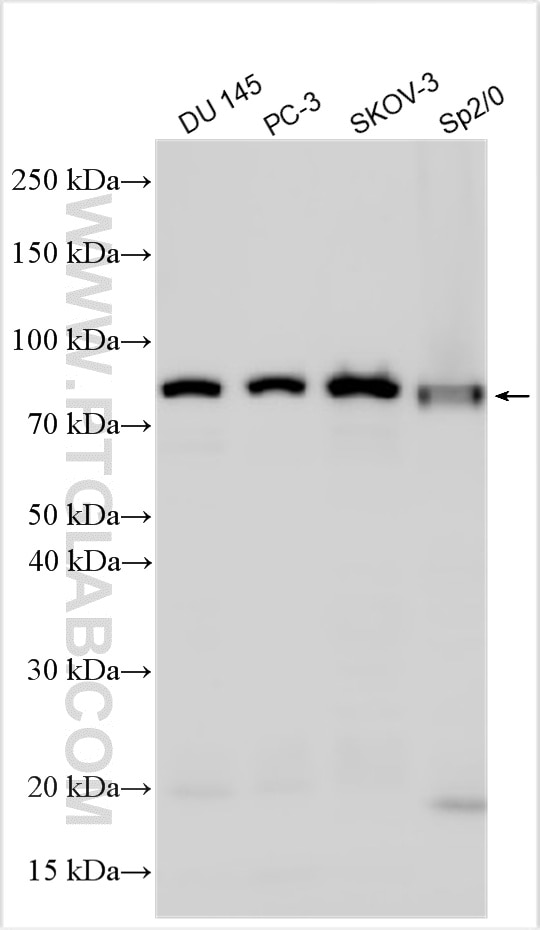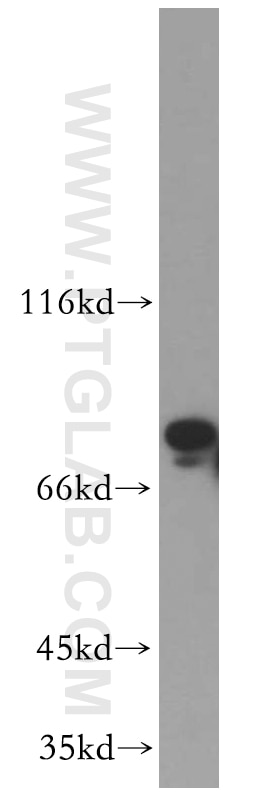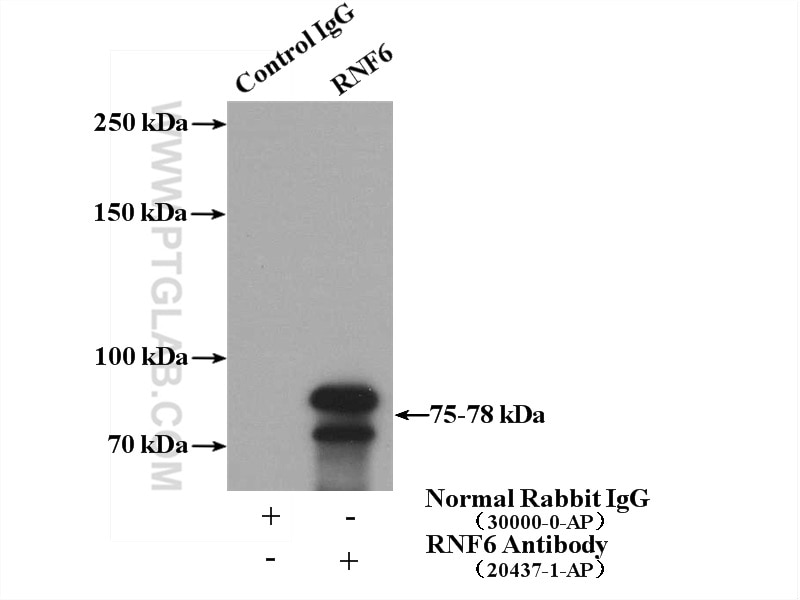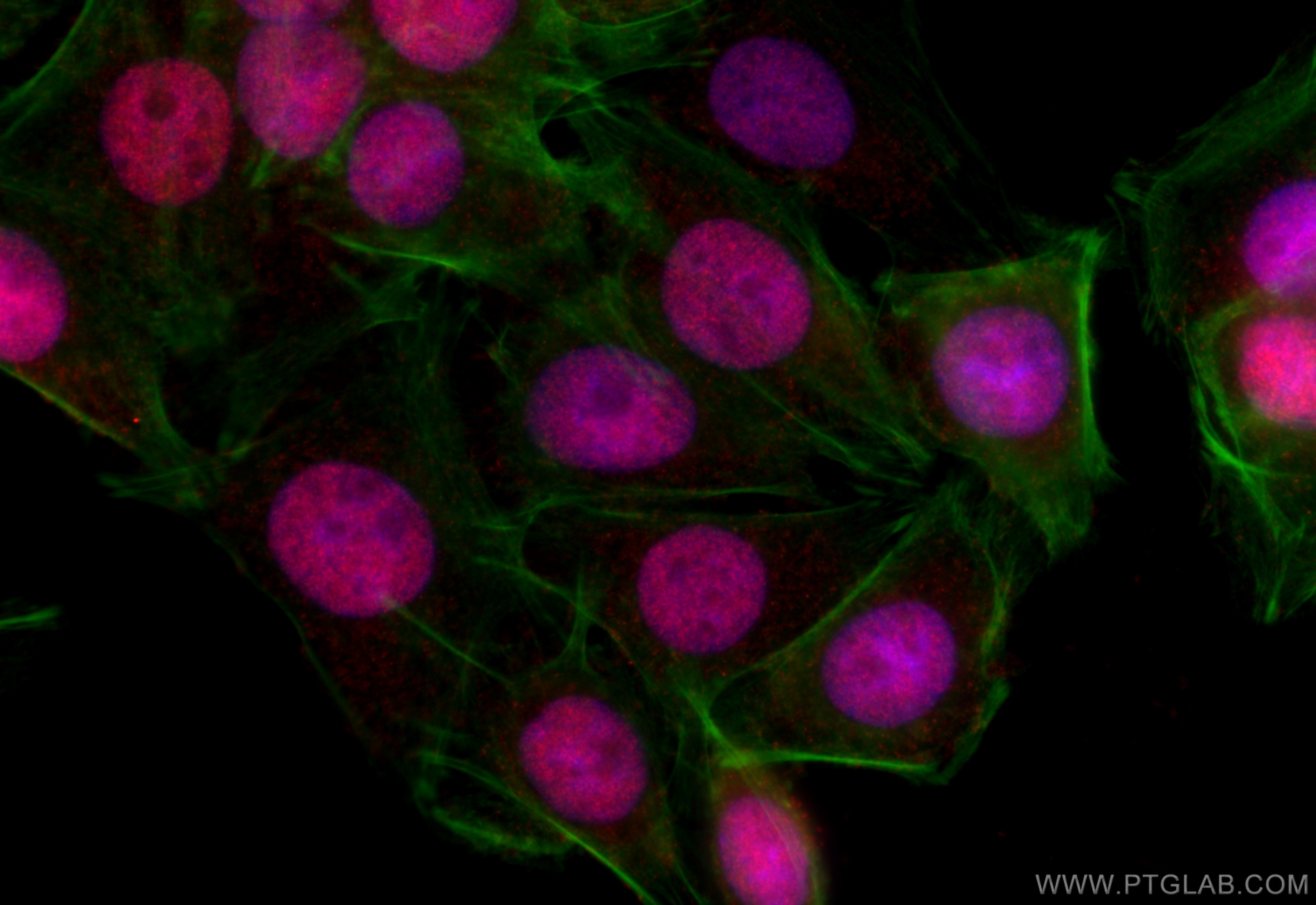- Phare
- Validé par KD/KO
Anticorps Polyclonal de lapin anti-RNF6
RNF6 Polyclonal Antibody for WB, IF/ICC, IP, ELISA
Hôte / Isotype
Lapin / IgG
Réactivité testée
Humain, souris
Applications
WB, IHC, IF/ICC, IP, ChIP, ELISA
Conjugaison
Non conjugué
N° de cat : 20437-1-AP
Synonymes
Galerie de données de validation
Applications testées
| Résultats positifs en WB | cellules DU 145, cellules PC-3, cellules SKOV-3, cellules Sp2/0, tissu testiculaire de souris |
| Résultats positifs en IP | tissu testiculaire de souris |
| Résultats positifs en IF/ICC | cellules SW480, |
Dilution recommandée
| Application | Dilution |
|---|---|
| Western Blot (WB) | WB : 1:1000-1:6000 |
| Immunoprécipitation (IP) | IP : 0.5-4.0 ug for 1.0-3.0 mg of total protein lysate |
| Immunofluorescence (IF)/ICC | IF/ICC : 1:50-1:500 |
| It is recommended that this reagent should be titrated in each testing system to obtain optimal results. | |
| Sample-dependent, check data in validation data gallery | |
Applications publiées
| KD/KO | See 1 publications below |
| WB | See 6 publications below |
| IHC | See 2 publications below |
| IF | See 1 publications below |
| IP | See 1 publications below |
| ChIP | See 1 publications below |
Informations sur le produit
20437-1-AP cible RNF6 dans les applications de WB, IHC, IF/ICC, IP, ChIP, ELISA et montre une réactivité avec des échantillons Humain, souris
| Réactivité | Humain, souris |
| Réactivité citée | Humain, souris |
| Hôte / Isotype | Lapin / IgG |
| Clonalité | Polyclonal |
| Type | Anticorps |
| Immunogène | RNF6 Protéine recombinante Ag14209 |
| Nom complet | ring finger protein (C3H2C3 type) 6 |
| Masse moléculaire calculée | 685 aa, 78 kDa |
| Poids moléculaire observé | 78 kDa |
| Numéro d’acquisition GenBank | BC034688 |
| Symbole du gène | RNF6 |
| Identification du gène (NCBI) | 6049 |
| Conjugaison | Non conjugué |
| Forme | Liquide |
| Méthode de purification | Purification par affinité contre l'antigène |
| Tampon de stockage | PBS with 0.02% sodium azide and 50% glycerol |
| Conditions de stockage | Stocker à -20°C. Stable pendant un an après l'expédition. L'aliquotage n'est pas nécessaire pour le stockage à -20oC Les 20ul contiennent 0,1% de BSA. |
Informations générales
RNF6 was firstly cloned in a genetic study of chromosomal rearrangements in myeloproliferative disorders, mapping to chromosome 13q12.12 [PMID:10331950]. It containing a coiled-coil domain at the N-terminus, and a RING-H2 finger at the C-terminus which is responsible for its ubiquitin ligase activity. It also activate Inha gene expression by participating in a protein complex binding to the promoter region [PMID:11971979]. In addition, LIMK1 is a substrate of RNF6 and the RNF6-induced LIMK1 polyubiquitination is mediated via K48 of ubiquitin and leads to proteasomal degradation of the kinase [PMID:16204183].
Protocole
| Product Specific Protocols | |
|---|---|
| WB protocol for RNF6 antibody 20437-1-AP | Download protocol |
| IF protocol for RNF6 antibody 20437-1-AP | Download protocol |
| IP protocol for RNF6 antibody 20437-1-AP | Download protocol |
| Standard Protocols | |
|---|---|
| Click here to view our Standard Protocols |
Publications
| Species | Application | Title |
|---|---|---|
Oncogene RING-finger protein 6 promotes colorectal tumorigenesis by transcriptionally activating SF3B2.
| ||
Cancer Lett Ring finger protein 6 enhances chemo-resistance by transcriptionally activating proliferating cell nuclear antigen expression and attenuating DNA damage in lung adenocarcinoma. | ||
Acta Pharmacol Sin RNF6 promotes myeloma cell proliferation and survival by inducing glucocorticoid receptor polyubiquitination. | ||
Anticancer Drugs miR-203a suppresses cell proliferation by targeting RING-finger protein 6 in colorectal cancer. | ||
J Biol Chem Induction of zinc finger protein RNF6 auto-ubiquitination for the treatment of myeloma and chronic myeloid leukemia | ||
Int J Biol Sci TRIM26 promotes non-small cell lung cancer survival by inducing PBX1 degradation |





